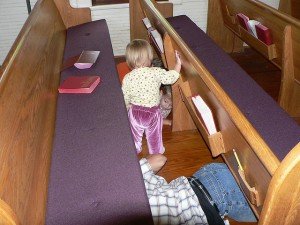I have recently finished an interesting book about Christian Education called Joining children on the Spiritual Journey: Nurturing a life of faith by Catherine Stonehouse. While I didn’t completely agree with everything the author said, her book gave me a lot to think about. Consider this statement
“Adults must provide a community in which children can hear the Word and can meet God. Children need a sense of belonging in the larger faith community and in their worship setting.”
Children who grow up involved in a congregational worship have the opportunity to experience the life of faith in words, music, stories, and liturgy. How wonderful! Further if they grow up with a strong sense of belonging in the worship setting of their faith community then perhaps they will continue to attend as they grow up. Notice that it is the adults of the existing congregation who are challenged to do what it takes to provide a welcoming community and sense of belonging. We need be talking about how can we create a sense of welcome for families. We might have to ask some hard questions. What is working? What changes should we make? How do we create accessible spaces where families feel at home during worship? What can we do to demonstrate to children and families that they truly belong?
Recently I become aware that an increasing number of Episcopal churches have taken the bold step of removing some of their pews in order to create “soft spaces.” Located in the nave, a soft space is a carpeted pew free area. They are carpeted, kept clean, and often contain baskets of toys. They are large enough to provide space for parents who wish to place blankets on the floor for their babies. Children are free to move around the space during worship, or to take toys from this space to the pews. Most importantly soft spaces are not tucked off in a corner, but are placed where there is a clear view of the sanctuary and communion table. Thus giving the children (and adults with them) a sense of full inclusion with the worshiping community.
Oh how I would have appreciated such a space when I was bringing my babies and toddlers to church. How wonderful to have a place large enough to spread out a blanket for a baby, or room where wiggly preschoolers can play. I particularly appreciate the way these spaces allow families to remain in the worship space. This is so much better than a segregated nursery, or the dreaded “crying room.”
I know it can be challenging having young children in the worship services. They are noisy, sometimes demanding, and don’t always respect the quiet moments in the service. I also know that removing a few pews would be a huge step for many congregations, but I would encourage you to imagine how strongly it would communicate your desire to invite families into your worshiping community.
Jesus told his disciples, “Let the little children come to me, and do not hinder them, for the kingdom of Heaven belongs to such as these.” (Matthew 19:13-14) Do our worship spaces help the children to come into Jesus’ presence, or are they more of a hindrance? It’s worth thinking about.

